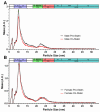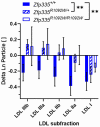This is a preprint.
Participant-derived cell line transcriptomic analyses and mouse studies reveal a role for ZNF335 in plasma cholesterol statin response
- PMID: 37397985
- PMCID: PMC10312755
- DOI: 10.1101/2023.06.14.544860
Participant-derived cell line transcriptomic analyses and mouse studies reveal a role for ZNF335 in plasma cholesterol statin response
Update in
-
Participant-derived cell line transcriptomic analyses and mouse studies reveal a role for ZNF335 in plasma cholesterol statin response.Genome Med. 2024 Jul 26;16(1):93. doi: 10.1186/s13073-024-01366-9. Genome Med. 2024. PMID: 39061094 Free PMC article.
Abstract
Background: Statins lower circulating low-density lipoprotein cholesterol (LDLC) levels and reduce cardiovascular disease risk. Though highly efficacious in general, there is considerable inter-individual variation in statin efficacy that remains largely unexplained.
Methods: To identify novel genes that may modulate statin-induced LDLC lowering, we used RNA-sequencing data from 426 control- and 2 μM simvastatin-treated lymphoblastoid cell lines (LCLs) derived from European and African American ancestry participants of the Cholesterol and Pharmacogenetics (CAP) 40 mg/day 6-week simvastatin clinical trial (ClinicalTrials.gov Identifier: NCT00451828). We correlated statin-induced changes in LCL gene expression with plasma LDLC statin response in the corresponding CAP participants. For the most correlated gene identified (ZNF335), we followed up in vivo by comparing plasma cholesterol levels, lipoprotein profiles, and lipid statin response between wild-type mice and carriers of a hypomorphic (partial loss of function) missense mutation in Zfp335 (the mouse homolog of ZNF335).
Results: The statin-induced expression changes of 147 human LCL genes were significantly correlated to the plasma LDLC statin responses of the corresponding CAP participants in vivo (FDR=5%). The two genes with the strongest correlations were zinc finger protein 335 (ZNF335 aka NIF-1, rho=0.237, FDR-adj p=0.0085) and CCR4-NOT transcription complex subunit 3 (CNOT3, rho=0.233, FDR-adj p=0.0085). Chow-fed mice carrying a hypomorphic missense (R1092W; aka bloto) mutation in Zfp335 had significantly lower non-HDL cholesterol levels than wild type C57BL/6J mice in a sex combined model (p=0.04). Furthermore, male (but not female) mice carrying the Zfp335R1092W allele had significantly lower total and HDL cholesterol levels than wild-type mice. In a separate experiment, wild-type mice fed a control diet for 4 weeks and a matched simvastatin diet for an additional 4 weeks had significant statin-induced reductions in non-HDLC (-43±18% and -23±19% for males and females, respectively). Wild-type male (but not female) mice experienced significant reductions in plasma LDL particle concentrations, while male mice carrying Zfp335R1092W allele(s) exhibited a significantly blunted LDL statin response.
Conclusions: Our in vitro and in vivo studies identified ZNF335 as a novel modulator of plasma cholesterol levels and statin response, suggesting that variation in ZNF335 activity could contribute to inter-individual differences in statin clinical efficacy.
Keywords: RNA-sequencing; Statin; cholesterol; gene expression; lipoprotein; lymphoblastoid cell lines; mice; zinc finger protein 335.
Conflict of interest statement
Competing interests The authors declare that they have no competing interests.
Figures






References
-
- Arnett DK, Blumenthal RS, Albert MA, Buroker AB, Goldberger ZD, Hahn EJ, Himmelfarb CD, Khera A, Lloyd-Jones D, McEvoy JW, et al.: 2019 ACC/AHA Guideline on the Primary Prevention of Cardiovascular Disease: A Report of the American College of Cardiology/American Heart Association Task Force on Clinical Practice Guidelines. Circulation 2019, 140:e596–e646. - PMC - PubMed
-
- Simon JA, Lin F, Hulley SB, Blanche PJ, Waters D, Shiboski S, Rotter JI, Nickerson DA, Yang H, Saad M, Krauss RM: Phenotypic predictors of response to simvastatin therapy among African-Americans and Caucasians: the Cholesterol and Pharmacogenetics (CAP) Study. Am J Cardiol 2006, 97:843–850. - PubMed
-
- Chasman DI, Giulianini F, Macfadyen J, Barratt BJ, Nyberg F, Ridker PM: Genetic Determinants of Statin-Induced Low-Density Lipoprotein Cholesterol Reduction: The Justification for the Use of Statins in Prevention: An Intervention Trial Evaluating Rosuvastatin (JUPITER) Trial. Circ Cardiovasc Genet 2012, 5:257–264. - PubMed
-
- Deshmukh HA, Colhoun HM, Johnson T, McKeigue PM, Betteridge DJ, Durrington PN, Fuller JH, Livingstone S, Charlton-Menys V, Neil A, et al.: Genome-wide association study of genetic determinants of LDL-c response to atorvastatin therapy: importance of Lp(a). J Lipid Res 2012, 53:1000–1011. - PMC - PubMed
Publication types
Associated data
Grants and funding
LinkOut - more resources
Full Text Sources
Medical
Miscellaneous
